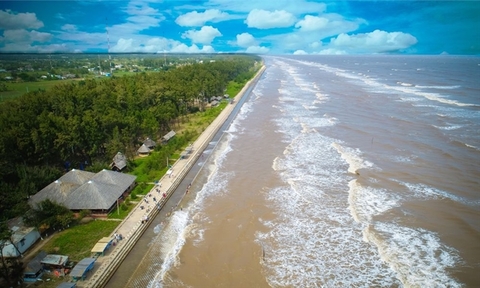
Investors are being sought for Ba Dong Beach, one of six tourism areas in Tra Vinh Province looking for new investment. — Photo from dulichtravinh.com.vn
The Cuu Long (Mekong) Delta province of Tra Vinh is calling for investment in six tourism areas, including Long Tri Islet, Ba Om Pond, Ba Dong Beach, Hang Duong, Tan Quy Islet and Duyen Hai hot mineral springs.
Duong Hoang Sum, director of the provincial Department of Culture, Sports and Tourism, said: “Tra Vinh is known for orchards, mangrove forests and sea activities suited to eco-tourism.”
Under the plan, orchards would be established on Long Tri Islet in Tra Vinh City and Tan Quy Islet in Cau Ke District. They are expected to cover 50ha each and cost a total of VND245 billion (US$10.55 million) in Long Tri and VND250 billion ($10.77 million) in Tan Quy.
Ba Dong Beach in Duyen Hai Town and Hang Duong in Cau Ngang District are expected to become beach tourism sites.
The 368-ha Ba Dong Beach will need investment capital of VND1.34 trillion ($57.75 million), while the 20-ha Hang Duong will cost VND150 billion ($6.46 million).
Ba Om Pond in Tra Vinh City is one of the most famous destinations in the Mekong Delta, and is surrounded by architectural relic sites like Ang Pagoda and the Museum of the Khmer Culture.
The Khmer annual festival called Ok Om Bok, which attracts thousands of local and foreign tourists, is also held near the pond.
The province expects to seek VND200 billion ($8.61 million) for the 65-ha Ba Om Pond Culture and Tourism Area and VND600 billion ($25.85 million) for the 30-ha Duyen Hai hot mineral spring eco-tourism area.
Sum said: “To reach the goal, we will offer special land rental prices, preferential taxes and streamlined procedures to investors."
Tra Vinh welcomed 765,400 tourists this year, a year-on-year increase of 66.46 per cent. Of these, 27,300 were foreign visitors.
Tourism turnover reached VND280 billion ($12 million), an increase of VND107 billion compared to the same period last year.
Tra Vinh targets turning tourism into its key economic sector by 2030.
“To reach the goal, we are improving state management of tourism, social order and safety, service quality at tourism attractions, and human resource training,” Sum said. — VNS